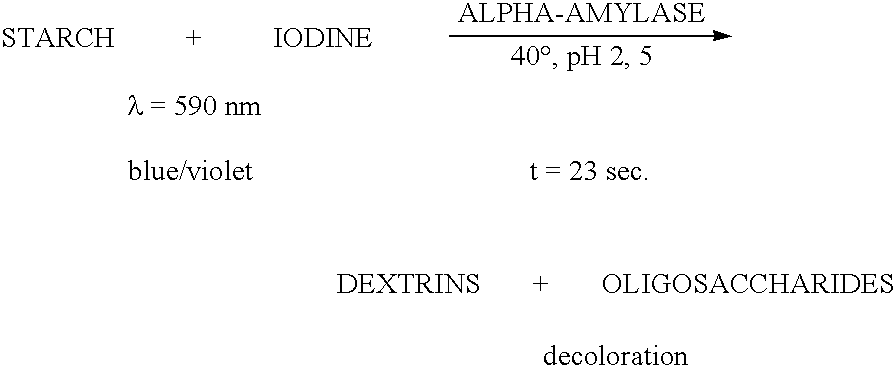Enzymes for starch processing
a technology of enzymes and starch, applied in the field of polypeptides, can solve the problems of energy-consuming conventional starch conversion process, achieve the effects of increasing the efficacy of various starch degrading processes, and reducing the cost of production
- Summary
- Abstract
- Description
- Claims
- Application Information
AI Technical Summary
Benefits of technology
Problems solved by technology
Method used
Image
Examples
example
Construction of the Nucleic Acid Sequence V019, Encoding Rhizomucor pusillus Alpha Amylases and Athelia rolfsii Glucoamylase CBM
[0218] Vector pLA1 was digested with the appropriate restriction endonuclease to cut out the region encoding A. niger alpha-amylase catalytic domain. The Rhizomucor pusillus alpha-amylase gene was amplified by PCR using the primers P001 (SEQ ID NO: 104) and P002 (SEQ ID NO: 105), the amplified fragment is shown as SEQ ID NO: 19.
PCR reaction system:Conditions:38.9 micro LH2O198° C. 10 sec 5 micro L10 × reaction buffer268° C. 90 sec 1 micro LKlen Taq LA (CLONTECH)1-230 cycles 4 micro L10 mM dNTPs368° C.10 min 0.3 micro L × 2100 pmole / micro L Primers 0.5 micro LTemplate DNA
[0219] DNA fragments were recovered from agarose gel by the Qiagen gel extraction Kit. The resulting purified fragments were mixed with the vector digest. The mixed solution was introduced into Saccharomyces cerevisiae to construct the expression plasmid pLAV019 by in vivo recombinatio...
example 2
Construction of the Nucleic Acid Sequence V022, Encoding Meripilus giganteus Alpha Amylase and Athelia rolfsii Glucoamylase CBM
[0220] The Meripilus giganteus alpha-amylase gene was amplified by PCR using the primers P003 (SEQ ID NO: 106) and P004 (SEQ ID NO: 107).
[0221] DNA fragments were recovered from agarose gel by the Qiagen gel extraction Kit. The resulting purified fragments and the appropriate restriction endonuclease digested vector pLA1 to cut out the region encoding A. niger alpha-amylase catalytic domain were mixed. The mixed solution was introduced into Saccharomyces cerevisiae to construct the expression plasmid pLAV022 by in vivo recombination.
example 3
Expression of Amylases With CBM in Aspergillus oryzae
[0222] The constructs comprising the alpha amylase genes with CBM described in examples 1 and 2 were used to construct expression vectors, pAspV019 and pAspV022, respectively. The two plasmids, pAspV019 and pAspV022, consist of an expression cassette based on the Asperigillus niger neutral amylas II promoter fused to the Aspergillus nidulans triose phosphate isomerase non translated leader sequence (Pna2 / tpi) and the Aspergillus niger amyloglycosidase terminator (Tamg). Also present on the plasmid was the Aspergillus selective marker amdS from Aspergillus nidulans enabling growth on acetamide as sole nitrogen source. The expression plasmids pAspV019 and pAspV022 were transformed into Aspergillus as described in Lassen et al. (2001), Applied and Environmental Micorbiology, 67, 4701-4707. Transformants expressing V019 and V022, were isolated, purified and cultivated in shake flasks. The culture broths from fermentations of Aspergil...
PUM
| Property | Measurement | Unit |
|---|---|---|
| Fraction | aaaaa | aaaaa |
| Fraction | aaaaa | aaaaa |
| Temperature | aaaaa | aaaaa |
Abstract
Description
Claims
Application Information
 Login to View More
Login to View More - R&D
- Intellectual Property
- Life Sciences
- Materials
- Tech Scout
- Unparalleled Data Quality
- Higher Quality Content
- 60% Fewer Hallucinations
Browse by: Latest US Patents, China's latest patents, Technical Efficacy Thesaurus, Application Domain, Technology Topic, Popular Technical Reports.
© 2025 PatSnap. All rights reserved.Legal|Privacy policy|Modern Slavery Act Transparency Statement|Sitemap|About US| Contact US: help@patsnap.com

